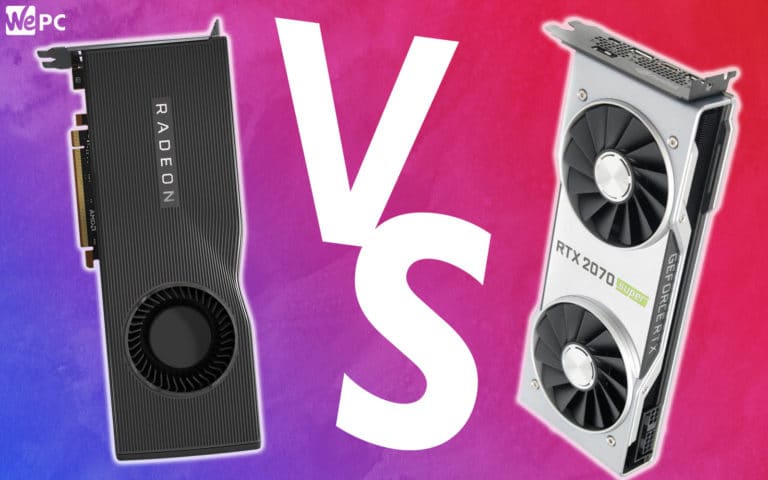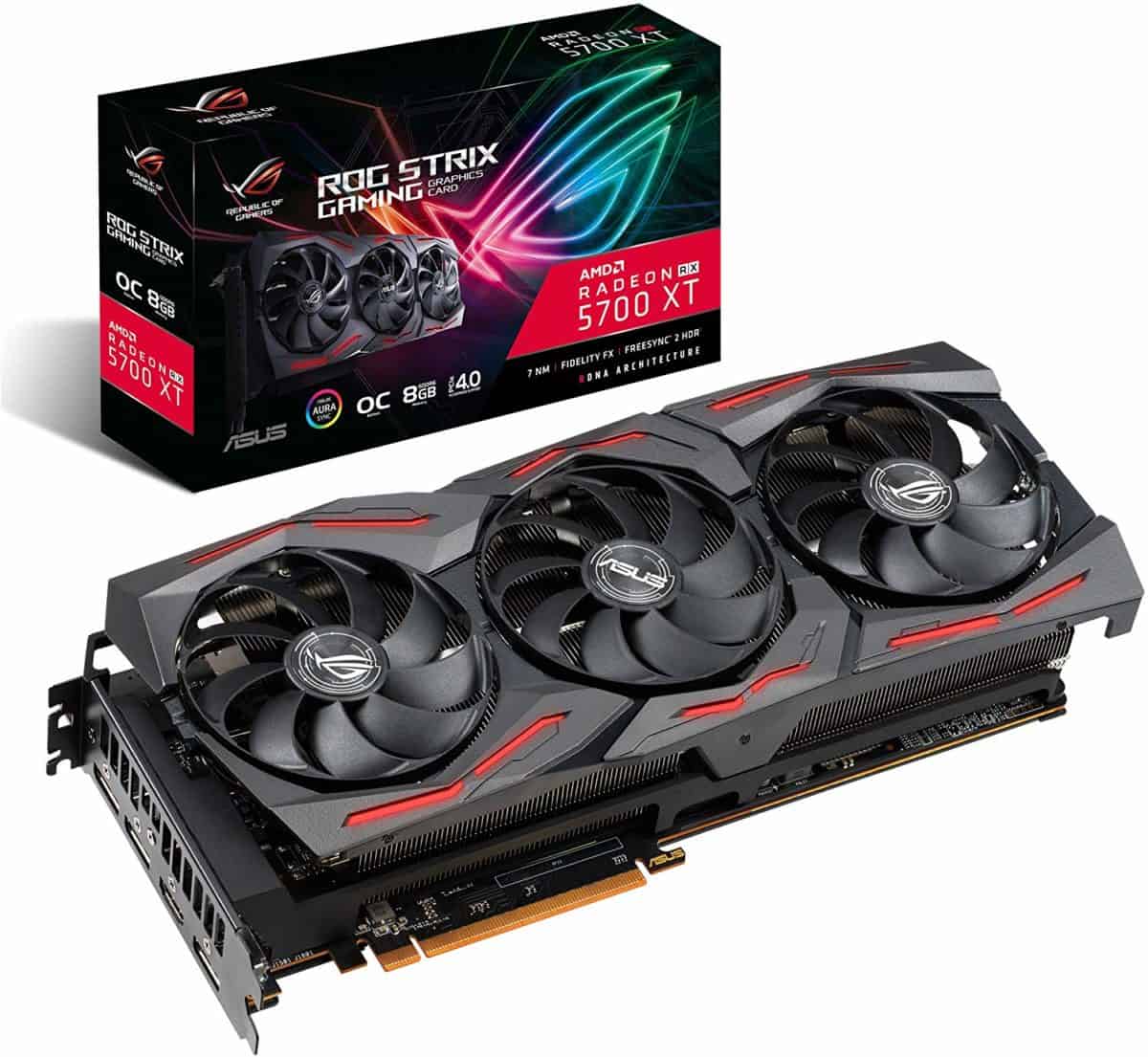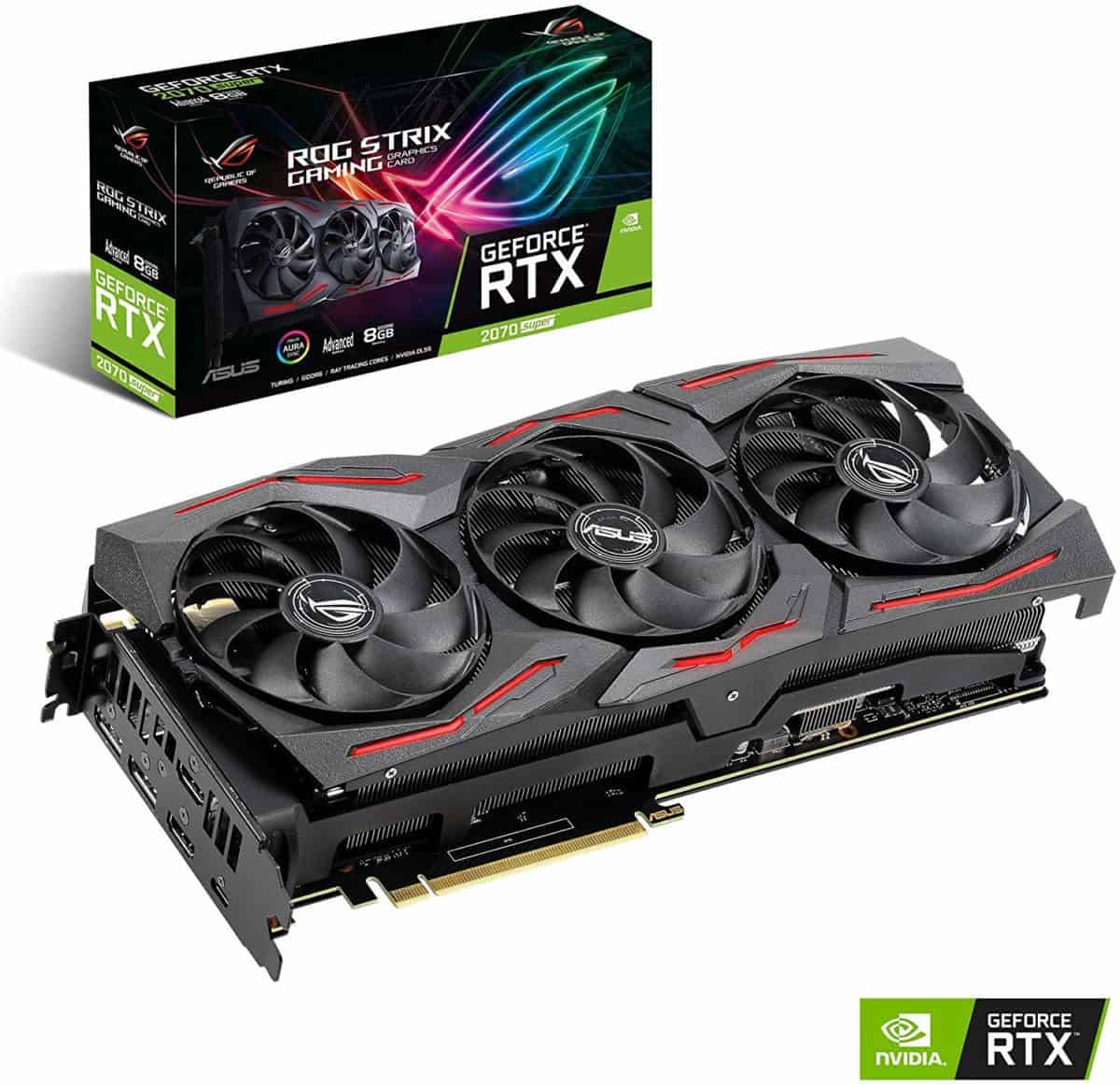5700 XT vs 2070 Super
This article examines the difference in performance of AMD’s 5700 XT and Nvidia’s 2070 Super

The original and somewhat prototypical chipsets for the GPUs in question, the Radeon 5700 and Nvidia 2070, were released just two days apart in April 2019, both striving for prime position in the high-end GPU market. By conducting a competitive profile of both of these amazing GPUs, we’ll crown an overall victor, and hopefully, in the process, illuminate some key features to help you decide which is best for your setup.
AMD vs Nvidia

ASUS ROG Strix AMD Radeon RX 5700XT Overclocked 8G

Clock Speeds
2035 MHz
VRAM
8GB GDDR6
Memory Bus Width
256 Bit
Excellent value for money
Comes to the table boasting the latest Navi architecture
Great for 1440p gaming
Quite large in dimensions
Does not come with ray-tracing

ASUS ROG STRIX GeForce RTX 2070 SUPER Advanced Overclocked

Clock Speed
1830 MHz Boost Clock
VRAM
GDDR6 8GB
Memory Bus Width
256 Bit
Great in-game performance
Very high build quality
Ray-tracing technology
Very efficient cooling
Few RTX-enabled games to enjoy
Nvidia is the current market leader, however, AMD are starting to claw back their share of the market. You’re probably already aware of their rivalry with Intel in the CPU game already. Well, these two conflicts create a perfect symmetry of discord, with AMD holding strong in the middle.
AMD has earned the respect and therefore wallets of countless gamers the world over due to their innovative approach to computer technology and consumer-friendly ethos, but Nvidia is still widely thought to occupy the stronghold for raw graphics processing power. The question is, can they keep it?
Architecture
Nvidia’s RTX 2070 Super has the same basic Turing microarchitecture as its 2070 predecessor, but this time around the TU106 graphics processor has been substituted with a suped-up TU104-410-A1 processor with 184 texture units.
Two now-infamous features of Nvidia’s Turing architecture are the specialized RT and Tensor cores. RT cores allow ray tracing on titles that support it, and Tensor cores facilitate DLSS which stands for deep learning super sampling, which, in Layman’s terms basically means more fps and enhanced overall quality.
The Super has 256 CUDA cores more than the standard 2070 bringing the total to 2560, meaning it definitely isn’t some redundant money-grabbing reiteration. It’s sufficiently juiced to out-perform its predecessor, but what about its competitor?
With 2560 in total, the Radeon 5700 XT matches the Super’s impressive core count exactly, although there’s bound to be some structural and performative differences between Turing CUDA cores and RDNA cores. This veritable treasure trove of cores is evenly split between two awesome shader engines harboring 160 texture units and 64 render output units.
At 1605MHz, both GPU’s base clocks are identical, but boosting them really shows what AMD is made of. The 5700 XT can reach an insane 2035MHz, obliterating the Super’s 1830MHz efforts.
Cooling
One little factoid you should know about the Super straight off the bat is that it’s not quite as energy-efficient as its archetype, but when you consider all the extras Nvidia’s managed to stuff in there without changing the 12nm formula, you have to expect it to be somewhat of a gas guzzler. Running on 215 watts, with a maximum thermal capacity of 88 °C, it makes sense to prioritize a decent cooling system for this GPU, or at the very least, make sure your case is ready to deal with the extra heat this open air GPU will release.
Surprisingly, though, the Nvidia card is by far the most energy-efficient of the two, but there’s a twist. Even though you’ll need a larger power supply to spark life into the 225-watt 5700 XT, it’s designed to run hot, so an ice-cold cooling system isn’t exactly necessary.
When we say it runs hot…we mean it. Its maximum temperature is 110 °C, and anything up to that is completely within spec.
Dimensions
Architecturally speaking, with a 7nm build, the 5700 XT is the smaller GPU, which is pretty impressive considering it’s squaring off core for core with Nvidia, but in terms of physical heft, there’s barely a belt size between them.
The AMD card is fractionally longer, measuring in at 10.7” (L) x 4.37” (H) x 2 slot (W), and the Nvidia card at 10.5” (L) x 4.556” (H) x 2 slot (W), is a tad taller. But enough of this skin deep breakdown. What do these GPUs have to offer in terms of substance?
Resolution and FPS
In 1080p, the 2070 Super, for lack of a better word, trounces the 5700 XT when it comes to real world gaming performance. It doesn’t just claim little victories here and there barely perceptible to the human eye. It’s a full-on G-PUnishment!
The smallest wins are for games such as Fortnite, but the difference in fps is still around 9%. GTA V and Overwatch provided the middle (yet impressive) victories with 11 and 12% differences respectively, but it’s the shooters such as GCSO that best exhibit the Super’s domination earning it a 24% win and nearing the 300fps mark. Nvidia’s GPU provides better lighting effects, better reflections, and performs 58% better when it comes to multi-rendering. That’s no hairline victory. That, my friends, is devastation for the AMD card.
If there were any doubts that Nvidia was out for blood, they’re put firmly to rest as the victories keep on pouring in in the 1440p category as well. We will, however, give the XT an honourable mention for catching up a bit during titles like Metro Exodus.
4K only confirms what we already know at this point. Averaging a 9% win across a number of titles, the 2070 Super is a stone cold killer.
Ray Tracing
It seems the 2070 Super doesn’t really need fancy cores to outperform the 5700 XT, but as a huge bonus, it does have them. RTX Turing architecture’s RT cores enable ray tracing, meaning – for games with adequate support – the Nvidia card delivers pristine and realistic shadows, reflections, and global illumination.
For a ray tracing AMD GPU, you’ll have to fork out for RDNA 2 architecture, or if you have the funds and the patience, RDNA 3 is expected any month now.
VRAM
We may be on the verge of writing the AMD card off, but it’d be criminal not to mention its awesome 8GB GDDR6 with 448GB bandwidth. The only problem is that the Super has the exact same memory configuration, so although AMD really brought it to this round, they could only pull a draw out of the bag.
Verdict
If you’re on the hunt for pure power, the obvious choice for you is Nvidia 2070 Super. 5700 XT managed to narrow the performative gulf between them in 1440p, but it’s still a ways off catching up to the Super.
The only problem with Nvidia cards, other than a higher price tag, is that you’re really only getting the most out of the Super’s specialized cores on Nvidia-sponsored titles that support RT and DLSS. Moreover, AMD holds contracts with both Sony and Microsoft, so it’s likely a lot of games will be designed with their RDNA architecture in mind.
All in all, both of these GPUs are amazing performers and are unlikely to let you down, but the truth is, the original not-so-Super 2070 was already a higher performing GPU than the 5700 XT, so AMD was always fated to lose this one.


